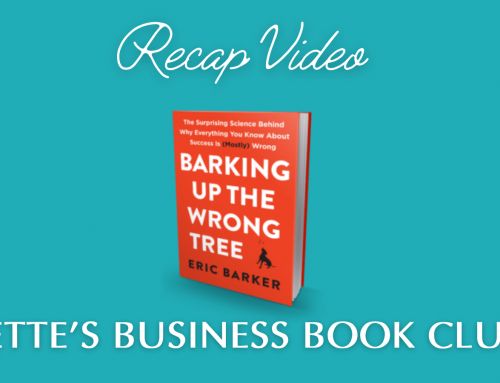We had a discussion, but the sound wasn’t recorded. Here is Bette’s summary of Clockwork by Mike Michalowicz.
Design your business to run itself. Often entrepreneurs find that their business is stuck. They can’t grow or expand and that is where they get stuck. They get stuck on the “survival track.” They deal with what’s urgent rather than what’s important. Use Clockwork to get unstuck.
Clockwork has you analyze the mix of the four Ds- doing, deciding, delegating, and designing. Then declare your corporate “queen bee role” (QBR), and that is the core function of your business and the biggest determinant of your company’s success. Do whatever it takes to protect and serve the QBR. Empower your team to make the company successful.
Capture systems. Clockwork wants you to document the systems you have in place to do work the way you want it done. Then shift your resources to get efficiency and the best quality. Next commit to the process to serve a specific customer in a specific way.
“Doing” is where you’re doing everything yourself. You know it and do well. The next phase is “deciding” where you start assigning tasks to other people. You you might tell them what to do and then at the end of the task being done, they come back and say, “What do I do now?” The next is “delegating.” You can assign a task to someone, and you give them the power to make decisions execution, giving ownership of the work to the employee. Designing” is the ever evolving vision of your company and flow of the business to support your vision.
To have your business run like Clockwork, you need to figure out your four D mix- the easiest way is to take a time sheet for a week and you go through your day and you write down the activity you’re working on and how long you worked on it. Then you total up the time spent on the four Ds to see what your four D mix looks like. Next declare the QBR.
To determine QBR-take six sticky notes and write one of the six most important things you do in your job (ex- sales or invoicing). Then on the top left corner, how much approximate time you spend doing that. Now two of these notes need to be removed. The four remaining are what you consider most important. Think about how you can do these four so effectively that it covers for the loss of the other two. Now, take out one more and the consideration is the same. And now remove one more. At the end, you’re left with just two sticky notes. Say which one is the one thing that’s so important it can never be removed. This is what you consider your QBR.
In Clockwork, the hub-and-spoke method shows you how to protect the QBR. You put your QBR in the center of a circle on a piece of paper. Take the five non-QBR notes from before, combined with your four D time analysis, and draw a spoke radiating out from your QBR circle, equating to the amount of time you spend on that task. Starting with the one that’s furthest away from the QBR, decide to trash (eliminate), transfer (delegate to somebody else) or trim (spend less time on) it. This is an iterative process to repeat to get you as close to the QBR as possible.
Capture your systems. Your business already has systems but they might not be documented. Clockwork shows you the best way to organize your various systems. Put them into one of four categories- attract (bringing in new customers), convert (you’re turning prospects into customers), deliver (supplying your customers), or collect (get paid). You want to have the right people do the right things in the right portions correctly. That you have good people that have various zones of genius, or an area they are best at and get the most joy from.
A lot of times entrepreneurs will say that it’s hard to find somebody or they can’t afford it, and they get stuck in their survival trap doing everything themselves. You should hire people with a get it done attitude, high energy, high intelligence, and who are a good cultural fit, not for skills.
Clarify who your customers are so that you can target your business’s effort. Look at your top clients, or create a persona of your dream customer. “Everyone” is not a market. Make a chart naming your customers in one column and their revenue in another. Sort revenue from most to least. Evaluate them as to whether they are a crush (you love them) or cringe (you hate) them. List what industry each crush falls into and find where they come together in organized situations.
Once you’ve done all of this analysis, and you’re trying to figure out how to improve all these different things, you’re going to see that you can really only fix one problem at a time. If you try to fix multiple things at once, break something at same time. Start with one issue, try to figure out how to fix it, test that, and then move to what the next likely issue. Then your business will run like Clockwork.
Find the book on Amazon.
Learn more about Mike and his other books here.










